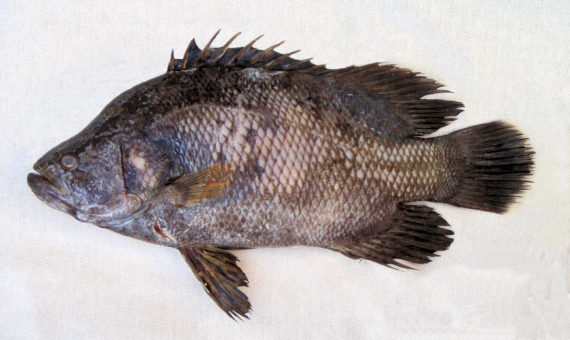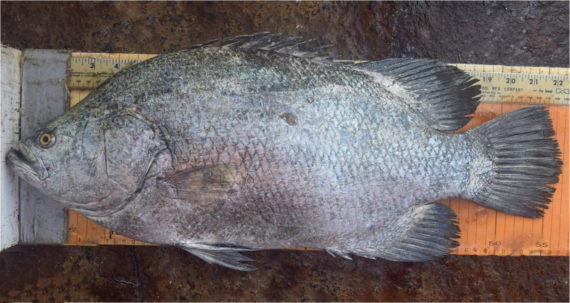Pacific Tripletail, Lobotes pacificus
 Pacific Tripletail, Lobotes pacificus. Fish provided by the commercial fishermen of the greater Los Cabos area, Baja California Sur, April 2014. Length: 30 cm (12 inches).
Pacific Tripletail, Lobotes pacificus. Fish provided by the commercial fishermen of the greater Los Cabos area, Baja California Sur, April 2014. Length: 30 cm (12 inches).
 Pacific Tripletail, Lobotes pacificus. Fish caught from coastal waters within Bahia Solano, Colombia, June 2019. Length: 43 cm (17 inches). Catch, photograph and identification courtesy of Chris Wheaton, Fullerton, California.
Pacific Tripletail, Lobotes pacificus. Fish caught from coastal waters within Bahia Solano, Colombia, June 2019. Length: 43 cm (17 inches). Catch, photograph and identification courtesy of Chris Wheaton, Fullerton, California.
 Pacific Tripletail, Lobotes pacificus. Fish provided by the commercial fishermen of Bahía Kino, Sonora, November 2014. Length: 56 cm (22 inches). Photograph courtesy of Maria Johnson, Prescott College Kino Bay Center, Kino Bay, Sonora.
Pacific Tripletail, Lobotes pacificus. Fish provided by the commercial fishermen of Bahía Kino, Sonora, November 2014. Length: 56 cm (22 inches). Photograph courtesy of Maria Johnson, Prescott College Kino Bay Center, Kino Bay, Sonora.
The Pacific Tripletail, Lobotes pacificus, is a member of the Tripletail or Lobotidae Family, and is known in Mexico as dormilona del Pacifico. Globally, there are two species in the genus Lobotes, both found in Mexican waters, one in the Atlantic and one, this species, in the Pacific Ocean.
The Pacific Tripletail has an ovate to oblong shaped compressed body. They have mottled color patterns that vary from dark brown to greenish-yellow dorsally and transition to silvery-gray ventrally. Their pectoral fins are pale yellow and all their other fins are dusky. Juveniles are mottled with yellow, brown, and black; their pectoral fins are white and their caudal fin has a white margin. Their head is triangular with a pointed snout, a slightly projecting top jaw, small eyes, and a mid-sized oblique mouth that extends to the front margin of the eyes. Their mouth has two sets of teeth: a row of outer canines and an inner band of small teeth. With age, their forehead becomes more concave. Their anal and second dorsal fins are large and match the rounded caudal fin giving them their “tripletail” common name. Their anal fin has 3 spines and 11 rays; their dorsal fin is continuous with 12 spines and 15 or 16 rays; and, their pectoral fins are shorter than the pelvic fins. Their gill cover is strongly serrated. They have 19 to 22 gill rakers. They are covered with rough scales.
The Pacific Tripletail is a coastal tropical pelagic species. They are normally solitary but can be found in large aggregates in bays, brackish waters, and well out at sea collecting under floating debris, shipwrecks, sea buoys, and piling of jetties at depths up to 46 m (150 feet). They reach a maximum 1.10 m (3 feet 7 inches) in length 15 kg (33 lbs) in weight. As of January 1, 2024, the International Game Fish Association world record stood at 12.13 kg (26 lbs 12 oz) with the fish caught in coastal waters off Quepos, Costa Rica, April 2023. They display the unusual behavior of floating just beneath the surface with one side exposed mimicking a leaf or floating debris as part of a mechanism to ambush prey. They consume small fish and invertebrates including crabs, shrimp, and other benthic crustaceans. In turn they are preyed upon by sharks and larger teleost fish. They are known to migrate to warmer waters during cold water episodes. The Pacific Tripletail is poorly studied with very limited information available about their lifestyle and behavioral patterns including specific details on age, growth, longevity, movement patterns, diet, habitat use, and reproduction.
The Pacific Tripletail is found in all Mexican waters of the Pacific Ocean.
The Pacific Tripletail is similar to, and can be confused with, the Star-studded Grouper, Hyporthodus niphobles (11 dorsal spines, second spine elongated) and the Tenspine Grouper, Hyporthodus exsul (10 dorsal spines). They are also virtually identical to the Atlantic Tripletail, Lobotes surinamensis (found only in the Atlantic Ocean).
From a conservation perspective the Pacific Tripletail is currently considered to be of Least Concern with stable, widely distributed populations. However, their catch levels and populations are poorly monitored. They are fished commercially on a limited basis and caught with seines, gill nets, and hook and line. They are also caught as a by-catch in tuna drift nets. They are marketed fresh, frozen, or salted. They are an infrequent catch of recreational fishermen but their popularity has been increasing due to their high quality meat.